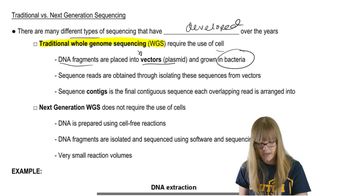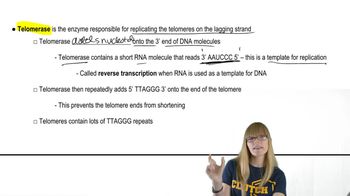Table of contents
- 1. Introduction to Genetics51m
- 2. Mendel's Laws of Inheritance3h 37m
- 3. Extensions to Mendelian Inheritance2h 41m
- 4. Genetic Mapping and Linkage2h 28m
- 5. Genetics of Bacteria and Viruses1h 21m
- 6. Chromosomal Variation1h 48m
- 7. DNA and Chromosome Structure56m
- 8. DNA Replication1h 10m
- 9. Mitosis and Meiosis1h 34m
- 10. Transcription1h 0m
- 11. Translation58m
- 12. Gene Regulation in Prokaryotes1h 19m
- 13. Gene Regulation in Eukaryotes44m
- 14. Genetic Control of Development44m
- 15. Genomes and Genomics1h 50m
- 16. Transposable Elements47m
- 17. Mutation, Repair, and Recombination1h 6m
- 18. Molecular Genetic Tools19m
- 19. Cancer Genetics29m
- 20. Quantitative Genetics1h 26m
- 21. Population Genetics50m
- 22. Evolutionary Genetics29m
7. DNA and Chromosome Structure
Eukaryotic Chromosome Structure
Problem 16a
Textbook Question
The accompanying chromosome diagram represents a eukaryotic chromosome prepared with Giemsa stain. Indicate the heterochromatic and euchromatic regions of the chromosome, and label the chromosome's centromeric and telomeric regions.
Are you more likely to find the DNA sequence encoding the digestive enzyme amylase in a heterochromatic, euchromatic, centromeric, or telomeric region? Explain your reasoning. <>
 Verified step by step guidance
Verified step by step guidance1
<span>1. **Identify Chromosome Regions**: Understand that a eukaryotic chromosome stained with Giemsa will show distinct banding patterns. Dark bands typically represent heterochromatic regions, which are tightly packed DNA, while lighter bands indicate euchromatic regions, which are less condensed and more transcriptionally active.</span>
<span>2. **Label the Centromeric Region**: The centromere is the constricted region of the chromosome, often appearing as a primary constriction in the diagram. It is crucial for the movement of chromosomes during cell division.</span>
<span>3. **Label the Telomeric Regions**: Telomeres are located at the ends of the chromosome. They protect the chromosome from degradation and prevent it from fusing with other chromosomes.</span>
<span>4. **Determine the Location of Amylase Gene**: The gene encoding the digestive enzyme amylase is likely found in euchromatic regions. These regions are less condensed, allowing for active transcription of genes, which is necessary for the production of enzymes like amylase.</span>
<span>5. **Explain the Reasoning**: Euchromatin is associated with gene-rich areas of the genome, where active transcription occurs. Since amylase is an enzyme that needs to be expressed, its gene is more likely to be located in euchromatic regions rather than heterochromatic, centromeric, or telomeric regions, which are less transcriptionally active.</span>
Recommended similar problem, with video answer:
 Verified Solution
Verified SolutionThis video solution was recommended by our tutors as helpful for the problem above
Video duration:
3mPlay a video:
Was this helpful?
Key Concepts
Here are the essential concepts you must grasp in order to answer the question correctly.
Euchromatin vs. Heterochromatin
Euchromatin is a less condensed form of chromatin that is actively involved in transcription, making it rich in genes and accessible for gene expression. In contrast, heterochromatin is tightly packed and generally transcriptionally inactive, often containing repetitive sequences and fewer genes. Understanding these differences is crucial for identifying where specific genes, like those encoding enzymes, are likely to be located.
Recommended video:
Guided course

Traditional vs. Next-Gen
Centromere and Telomere
The centromere is the region of a chromosome that links sister chromatids and is essential for proper chromosome segregation during cell division. Telomeres are repetitive nucleotide sequences at the ends of chromosomes that protect them from degradation and prevent fusion with neighboring chromosomes. Both regions are typically not involved in gene encoding, which is important when considering where to find specific gene sequences.
Recommended video:
Guided course

Telomeres and Telomerase
Gene Location and Function
The location of a gene within a chromosome can influence its expression and function. Genes that are actively expressed, such as those encoding enzymes like amylase, are usually found in euchromatic regions, where the chromatin is more open and accessible. This concept is vital for understanding why certain genes are located in specific chromosomal regions and how this affects their expression.
Recommended video:
Guided course

Functional Genomics

 7:10m
7:10mWatch next
Master Chromosome Structure with a bite sized video explanation from Kylia Goodner
Start learningRelated Videos
Related Practice



